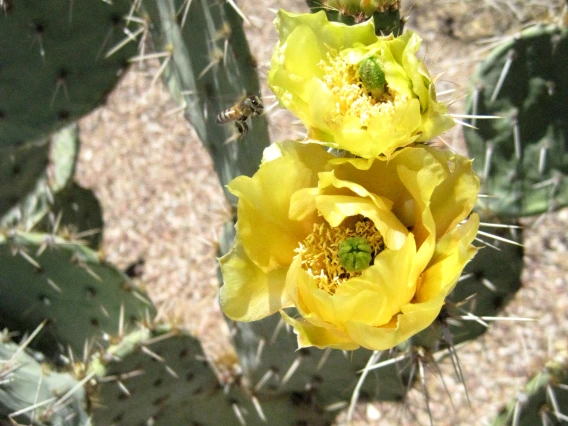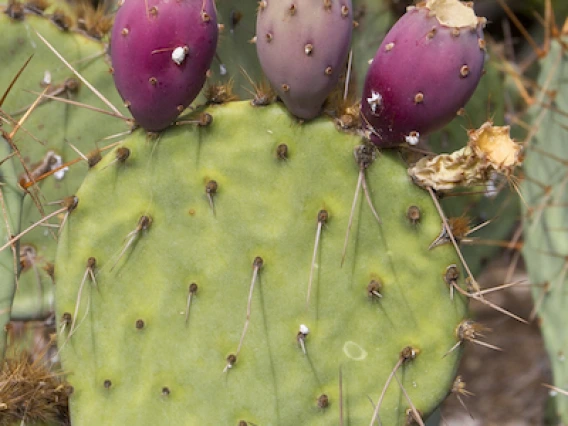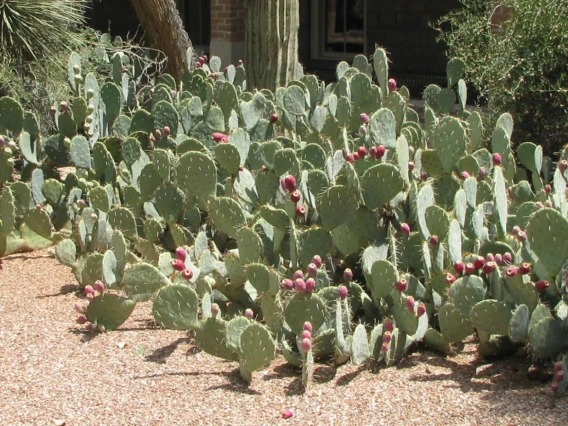


Botanical Name: Opuntia engelmannii
Common Names:
English: Engelmann's Prickly Pear
Spanish: Nopal
O'odham: L:ibhai naw
Family: Cactaceae
Rain Garden Zone: O. engelmannii thrives in the top Rain Garden Zone, but may also grow well in the terrace Rain Garden Zone. (1)

Reproduced with permission from "Rainwater Harvesting for Drylands and Beyond" by Brad Lancaster, HarvestingRainwater.com
Flowering Season: April--June
Harvest Season:
Fruit: Late July--October
Pad: April, May
Harvest Techniques: Harvest prickly pear pads that are young, shiny, and bright green. Young pads have not yet developed a tough, fibrous inner network; additionally, yound pads generally contain less oxalic acid than their mature counterparts. These tender green pads (nopales) of the prickly pear may be harvested with tongs to avoid spines and glochids. Using tongs, grip the pad at the base and twist for easy removal. Remember, spines and glochids much be removed before use--do so with a kitchen knife or vegetable peeler, or carefully hold the pad over a flame to burn off spines and glochids, and then scrape down with a kitchen knife. (2)
Planting Season: Monsoon
Landscape Cultivation: Both single pads and larger cuttings may be planted in soil so long as som if the areoles (points at which clusters of spines grow) are buried and can take root. (5)
Characteristics: O. engelmannii is a large species of prickly pear cactus reaching a height of 4 to 6 ft, spreading up to 15 ft. Mature pads of this prickly pear grow to approximately 6 to 16 ft long and 4 to 16 ft wide, and are yellowish green to blueish green. Areoles grow in diagonal lines across the pads, and grow up to 6 straight or slightly curved spines each. Young pads are shiny, bright green, and tender. Flower petals are numerous and are commonly bright yellow, but may range to pale yellow, orange, or pink. The barrel shaped fruits of O. engelmannii are spineless and fleshy, reaching a deep red to purple when ripe (3)
Ecology: O. engelmannii is considered of special value to native bees (4). Prickly pear is a host plant for cochineal, which colonizes areas of the pad with poor air circulation (6).
Ethnobotany:
Food:
The fruits of the prickly pear cactus, commonly named tuna in Spanish or l:ibhai in O'odham, are a great soruce of calcium, omega-3 and omega-6 fatty acids, vitamins A and C, magnesium, dietary fiber, potassium, and phosphorus. Both the fruits and pads provide hydration and work to stabilize blood sugar. Fruits may be harvested and eaten fresh, made into juice, cooked down into syrups, or sliced up and added to salsas or salads. Slice up the tender young pads and cook them into a dish called nopalitos, to be eaten with egg breakfasts, in tacos or burros. (2)
Domestic Animals:
Prickly pear can be used as fodder for the desert tortoise (2).
Other:
The bright, pigmented prickly pear fruits may be used as a natural, plant-based dye. Indirectly, red dyes may be made from the cochineal that grows on the pads of many prickly pears. Beach the fruits and pads work to stabilize blood sugar and increase hydration, nopal has traditionally be used as a medicinal. Prickly pear is vastly speading and may be used as a "living fence" for yards or lawns (1, 2).
References:
- Lancaster, B. (2006) Rainwater harvesting for drylands and beyond. Tucson, AZ. RainSource Press.
- Desert Harvesters. (2018). Eat mesquite and more: a cookbook for Sonoran desert foods and living. Tucson, AZ. RainSource Press.
- SEINet
- Wildflower.org
- Jones, W. and Sacamano, C. (2000). Landscape Plants for Dry Regions. Tucson, AZ. Fisher Books LLC. Print
- http://www.public.asu.edu/~camartin/plants/Plant%20html%20files/opuntia…
For more information on this plant, see the Campus Arboretum species description pages.
Go to the next tour stop: Murphey's agave page or Return to the main Dunbar Spring tour page

